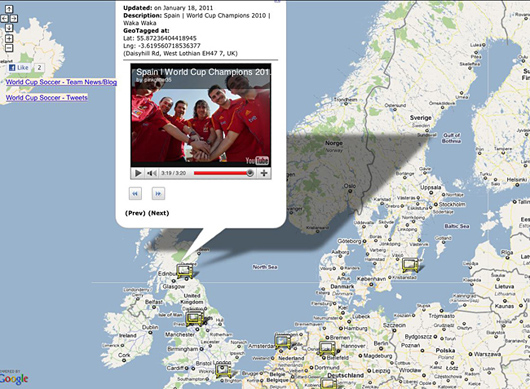
A location-based mashup uses APIs to plot YouTube videos about the World Cup on a global map using geotagging. There are countless ways in which brands can use APIs.
 In Silicon Valley, open APIs have long been a staple of how tech companies do business. Twitter has an API. Facebook and Yahoo! have APIs. Google kick-started the API phenomenon with the Google Maps API. eBay and Amazon.com pioneered APIs as a lucrative business model.
In Silicon Valley, open APIs have long been a staple of how tech companies do business. Twitter has an API. Facebook and Yahoo! have APIs. Google kick-started the API phenomenon with the Google Maps API. eBay and Amazon.com pioneered APIs as a lucrative business model.
Now an increasing number of brands are getting in on the action: Best Buy, Sears, MasterCard, MTV and Rhapsody now sport APIs alongside upstarts like HotUKDeals, Zappos and Wine.com.
At last week’s Content Marketing Strategies conference in Berkeley, Calif., Lori H. Schwartz, chief technology catalyst for McCann WorldGroup, said that smart brands are increasingly turning to APIs as a way to entice would-be partners to take your datastream and reuse it in the burgeoning number of different media environments: mobile, Internet-enabled TV, the real-time Web and other places where customers are increasingly hanging out.
A quick primer for readers who aren’t familiar with APIs. An API, short for application programming interface, is simply a set of rules and protocols that allow websites and apps to work with each other. A typical API pulls data from a source – say, pricing data or inventory – and performs a function, such as parsing the content and displaying it in a new way – say, a nicely formatted row of Flickr photos, or text that appears larger for the vision-impaired.
APIs let businesses plug into the social Web
Businesses large and small are now catching on, as brands are evolving into social media platforms rather than stand-alone destination sites.
The North Face and REI have released skiing apps that display snow conditions at dozens of resorts along with forecasts, trail maps and more. Real-time weather data is pulled into the apps through APIs. Etsy, an online retailer of handmade merchandise, has cultivated a distributed network of developers who used the Etsy API to create apps like Etsy On Sale and SoopSee. Best Buy recently released a new AP:I that not only lets you browse its vast catalog of merchandise but lets you take part in an end-to-end transaction on a third party site.
As brand strategist Brian Phipps writes: “The monolithic brands of the industrial age are giving way to the distributed, participative and democratized brands of the digital age. The forward strength of brands will be free-flowing from the bottom-up, rather than dictated and manipulated from the top down.”
Here are four reasons why your brand should consider creating its own APIs:
1. Increased sales
Depending on what you’re selling on your destination website, there’s a good chance that you’ll be able to drive additional sales by deputizing bloggers, affiliate retailers and boutique online shops into becoming part of the sales process. Make it easy for ecommerce allies to grab relevant data and present it to the world using their interface but adhering to your standards. If you’re lucky, a Web service developed by a third party could generate new sources of revenue.
2. Increased innovation
What if the community built new products and services on top of your brand’s foundation? The magic of APIs is that your development team and contractors don’t have to create solutions for every possible use of your product or service in the marketplace. You do know that you can’t possibly handle every imaginable use case and build for every platform and media format, don’t you? In a sense, APIs are the ultimate form of crowdsourcing. By releasing an open API with specific terms of use, you turn the community into developers and co-collaborators for your brand – at almost zero cost. By building out an external developer ecosystem, you’re essentially adding outside expertise and novel insights to your R&D process.
3. Synergy with new partners
Chances are that the marketplace holds potential partners for your brand that you’re not even aware of. APIs enable business-to-business interactions by opening data and processes to partners, either freely or through a commercial license. [[you need to reach them through surrogates acting on your behalf, armed with useful APIs.]] APIs can target specific communities or networks – say, if Johnson & Johnson created an API offering discounted baby merchandise to mommy bloggers on BlogHer.
4. Increased customer satisfaction
We live in a social media world now. Customers are increasingly expecting brands to be social – to listen to conversations and embrace community input instead of just pushing out marketing messages. APIs let clever outsiders experiment with finding out what customers want – and giving it to them. If your name is BevMo, chances are that your customers don’t just want to know which wines Wilfred Wong recommends – they’d like suggestions from their own favorite experts, or perhaps from fellow wine lovers.
Have a question about APIs? Want to discuss how your brand might use this approach? Post a comment or contact me. And please share your insights below.
Cross-posted — see the full version on Econsultancy.
JD Lasica, founder of Inside Social Media, is also a fiction author and the co-founder of the cruise discovery engine Cruiseable. See his About page, contact JD or follow him on Twitter.

Leave a Reply